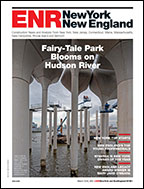Dubai’s explosive buildout may be no better exemplified than its construction of a series of palm-shaped islands directly offshore of the coastline. Discernable from space, the islands will host a number of pricey, ultra-luxury developments for a wealthy clientele drawn to the emirate’s business centers and leisure resorts.
Occupants of villas and apartments built on fronds of Dubai’s 560-hectare artificial Palm Jumeirah island this month are to begin moving in as the project’s first phase nears its end. The estimated $6-billion residential and hotel development is the first of three palm-shaped reclamations that will increase Dubai’s waterfront from 70 kilometers to nearly 600 km.
Jumeirah’s living and working population will be around 140,000 people. The next two islands, Palms Deira and Jebel Ali will be even bigger. And with Jebel Ali’s onshore waterfront development, people on all projects will approach two million, exceeding Dubai’s current population. And that’s before “The World” array of islands gets going.
Extending about 5 km in both directions, Palm Jumeirah resembles a palm tree with building plots on 17 fronds, which are roughly 250 m wide and up to 2 km long. Hotels and leisure developments will be built on its 11-km-long, 200-m-wide enclosing breakwater.
The palm’s 3.5-km-long stem is a major transportation corridor carrying 12 highway lanes and a $400-million, 5.4-km-long monorail for 6,000 passengers per hour, each way. Japan’s Marubeni Corp. started three years of work this spring, supervised for local developer Nakheel Properties by the Mott MacDonald Group, Croydon, U.K.
Nakheel has largely completed some 1,400 villas on the fronds and 2,650 apartments in 20 blocks on one side of the stem. With the stem being the sole access, logistics has been a major challenge, says Michael Reign, project executive with Hill International, Marlton, N.J. Hill was project manager of the palm’s reclamation in up to 10 m of water through completion two years ago. Hill is now taking care of construction of $800 million of villas in phase one of Nakheel’s building program. Parsons Brinckerhoff, New York City, won the management contract for the island’s infrastructure. Turner Construction International, Dallas, is handling the apartment blocks.
Another developer began three years of construction of the $1.5-billion Atlantis Hotel complex on the breakwater’s apex last December. Over 30 five-star hotels will be built by other investors in the second phase. The tallest hotel, at 255 m and 60 floors, will be the 200,000-sq-m Palm Trump International Hotel and Tower. The $550-million building is being developed by Nakheel and New York-based Donald Trump organization.
 Nakheel
|
 Atkins
Jumeirah's "stem" is a major transportation corridor, including a monorail, all watched over by Dubai's own Trump Tower. Some 140,000 people will live and work on the reclaimed land.
|
Total design of the two-leg “iconic” tower is being handled by the local office of Atkins Middle East Ltd. Initially called in to review an earlier concept, resembling an opening Fabergé egg, Atkins got the job itself. “Very quickly, from looking at [the first design] we knew we could probably do a better job,” says Lee Morris, Atkins associate director.
Nakheel has had eight main contractors and 54 subs working on the villas, says Reign. China State Engineering Construction Corp. has been the only non-local firm. “They have been one of the most productive,” he says. To reduce transit, 3,000 of its peak 20,000 workers are camped on a frond.
Already unhappy with the existing architect’s lack of local presence, Nakheel Development Vice President Sunil Gomes, took up Atkins’ references “and was very impressed,” he says. “Plus, they had a large team on the ground.” Within eight weeks, Atkins did enough design for a presentation to Donald Trump in New York City, says Gomes. Nakheel will be ready to bid the project around next autumn, aiming for a 2010 opening.
Masterplanning the next island, Palm Jebel Ali, is under review, and reclamation is complete. With residential building on the 7.5x 7.5-km palm about to start, project managers are lining up for work. “The island is so big, work will be split among the big players,” says Abdo Kardous, Hill senior vice president.
The much bigger 14.9 x 8-km Palm Deira, close to the city, is over 10% reclaimed. Nakheel’s fourth offshore development, The World, extending 8.9 by 8 km, is a different commercial proposition. The firm will provide individual island building plots for buyers, reportedly charging them from $6 million to nearly $2 billion.
The World will have 300 islands shaped like countries and arranged as a globe. Located about 4 km offshore, The World is in deeper water than the palms, ranging from 8 m to about 14 m, says Shaun Lenehan, Nakheel’s senior environmental manager.
 AP
Building 1,400 villas on the "fronds" was a logistical challenge.
|
About 80% of The World’s reclamation is done and Nakheel is working out how to deal with sewage, water and power utilities. Nakheel will provide essential utilities for the palms. But The World developers will be more self-sufficient, though some centralized utilities are possible. The likes of Hill and Turner will not likely be involved in developing islands bought for personal use, by singer Rod Stewart and others. But they will be interested in multi-billion dollar plans by Kuwaiti-owned Oqyana Real Estate Co.
Having appointed masterplanning and environmental consultants, Oqyana aims to build thousands of homes on the largest cluster of some 20 islands around Australasia, extending to an uncharacteristically warm South Pole.

 Full Dubai Coverage
Full Dubai Coverage 


